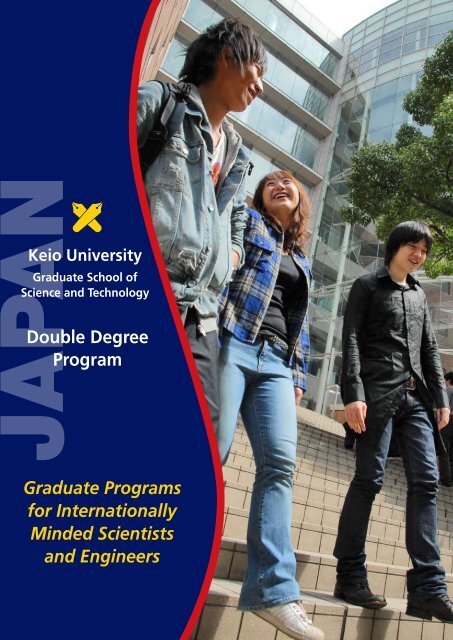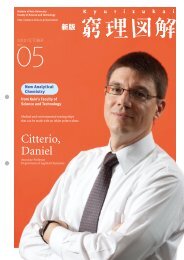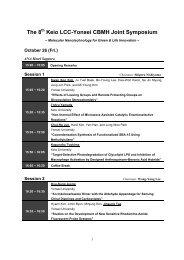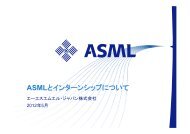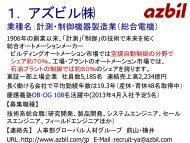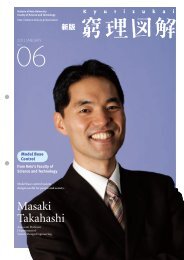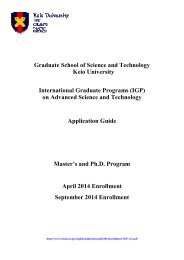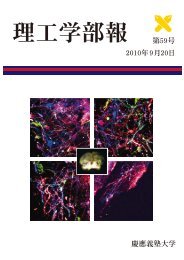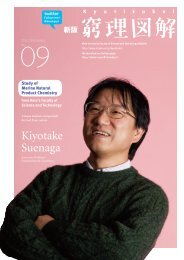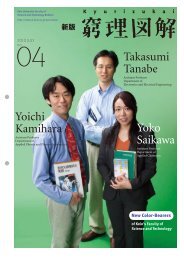Double Degree Program Graduate Programs for ... - Keio University
Double Degree Program Graduate Programs for ... - Keio University
Double Degree Program Graduate Programs for ... - Keio University
You also want an ePaper? Increase the reach of your titles
YUMPU automatically turns print PDFs into web optimized ePapers that Google loves.
JAPAN<br />
<strong>Keio</strong> <strong>University</strong><br />
<strong>Graduate</strong> School of<br />
Science and Technology<br />
<strong>Double</strong> <strong>Degree</strong><br />
<strong>Program</strong><br />
<strong>Graduate</strong> <strong>Program</strong>s<br />
<strong>for</strong> Internationally<br />
Minded Scientists<br />
and Engineers
Message from the <strong>Graduate</strong> School of Science and Technology<br />
What Size Is Your World?<br />
The founder of <strong>Keio</strong> <strong>University</strong>, Yukichi Fukuzawa, was one of the first Japanese<br />
2<br />
MESSAGE<br />
to experience the vastness of the world beyond Japan. In 1860, only two years<br />
after he founded <strong>Keio</strong> <strong>University</strong>, he sailed to the United States, and two years<br />
later he visited Europe. He introduced the immensity of the world to the Japanese,<br />
who knew little outside their own country and explained its significance through<br />
great writings such as Seiyo Jijo (Conditions in the West) and Bunmeiron no Gairyaku<br />
(An Outline of a Theory of Civilization).<br />
It has been 150 years since Yukichi Fukuzawa began his travels, and in that<br />
time the world has become both more complex and more accessible. We invite<br />
you to travel to Japan and study at <strong>Keio</strong> <strong>University</strong>, one of the country’s most<br />
prestigious universities, to explore and understand those complexities.<br />
At <strong>Keio</strong>, you will prepare yourself to become a top-rank scientist and/<br />
or engineer. You will gain invaluable experience learning how Japanese<br />
industries function and meet engineers who develop cutting-edge<br />
technologies, and your ability to connect across cultures will establish<br />
you as a truly multicultural person with a broad perspective.<br />
Today, it is our own energy and range of activities that determine<br />
whether we see the world as excessively large or com<strong>for</strong>tably small.<br />
Let <strong>Keio</strong> be your gateway to a perfectly sized world.
KEIO Introducing<br />
<strong>Keio</strong> <strong>University</strong><br />
Progress and Innovation<br />
History<br />
<strong>Keio</strong> <strong>University</strong> is Japan’s oldest private university, founded in 1858<br />
by the internationally minded Yukichi Fukuzawa. After traveling<br />
extensively in Europe and the United States, Fukuzawa (whose portrait<br />
is on the 10,000 yen note) was convinced that a global perspective is<br />
essential <strong>for</strong> success and leadership. As a result, <strong>Keio</strong> has always placed<br />
a high priority on educating students in an atmosphere of international<br />
learning and cooperation.<br />
Priding itself on progress and innovation, the university is in a constant<br />
state of growth, and presently consists of 10 undergraduate faculties and<br />
14 graduate schools on six different campuses, as well as seven affiliated<br />
schools, a medical institution and several research centers.<br />
For more in<strong>for</strong>mation about the university and its history, see<br />
http://www.keio.ac.jp/english/about_keio/index.html<br />
Research Activities<br />
<strong>Keio</strong> has more than 30 research centers on its main campuses and at other<br />
facilities, making it one of the primary engines <strong>for</strong> advanced research in<br />
Japan. In fiscal 2008, research funds totaled 17 billion yen (188 million<br />
US$), and there were 2,101 researchers and 356 visiting researchers.<br />
Global Partnerships<br />
<strong>Keio</strong> has 242 partnerships with universities and organizations in 44<br />
countries, involving both education and research in wide-ranging areas.<br />
Students from partner universities pursue degree work and research<br />
projects in English, and are able to study Japanese as well. At the<br />
institutional level, joint research projects are underway with over 200<br />
organizations.<br />
Europe<br />
77 Partners<br />
Middle East<br />
2 Partners<br />
Africa<br />
1 Partner<br />
Asia<br />
70 Partners<br />
Partner data as of February 2008. International student data as of May 2009.<br />
1053<br />
International<br />
Students<br />
Oceania<br />
7 Partners<br />
International Organizations<br />
5 Partners<br />
3<br />
North America<br />
54 Partners<br />
Central & South America<br />
4 Partners<br />
Jean Klingler (EC Lille)<br />
Why did you first become interested<br />
in DD <strong>Program</strong>?<br />
Be<strong>for</strong>e “integrating” Ecole Centrale, I was<br />
interested in the international possibilities<br />
offered by the different Grandes Ecoles<br />
and was already thinking about doing a<br />
DD <strong>Program</strong>. After two years of Classes<br />
Preparatoires, I was aiming <strong>for</strong> a new<br />
challenge, which would be likely to<br />
increase my open-mindedness along with<br />
my polyvalence, so I thought that an<br />
international mobility would meet this<br />
expectation perfectly. Besides the fact that<br />
such a program could truly be a valuable<br />
asset to start an international career,<br />
which is my objective, it is also a unique<br />
opportunity to acquire a new <strong>for</strong>eign<br />
language and to live a very pleasant cultural<br />
and human experience.<br />
Undergraduate Faculties<br />
Letters<br />
Economics<br />
Law<br />
Business & Commerce<br />
School of Medicine<br />
Science & Technology<br />
<strong>Graduate</strong> Schools<br />
Letters<br />
Economics<br />
Law<br />
Human Relations<br />
Business & Commerce<br />
School of Medicine<br />
Science & Technology<br />
Business Administration<br />
(<strong>Keio</strong> Business School)<br />
Policy Management<br />
Environmental<br />
In<strong>for</strong>mation<br />
Nursing & Medical Care<br />
Pharmacy<br />
Media & Governance<br />
Health Management<br />
Law School<br />
System Design and<br />
Management<br />
Media Design<br />
Pharmacy
Introducing Yagami Campus<br />
The <strong>Graduate</strong> School of<br />
Science and Technology<br />
Broad Curriculum with Great Flexibility<br />
Located on the Yagami Campus, the <strong>Graduate</strong> School of Science and Technology<br />
has 1,638 Japanese students, 153 international students and a teaching staff of<br />
571, including 288 part-time lecturers (2009 figures). It offers degrees in 11 fields of<br />
4<br />
YAGAMI<br />
study, which are integrated into three schools: the School of Fundamental Science<br />
and Technology, the School of Integrated Design Engineering, and the School of<br />
Science <strong>for</strong> Open and Environmental Systems.<br />
The strength of this integrated system is that it provides a flexible structure<br />
that enables a transdisciplinary education in which students can freely access<br />
different fields of study. Each of the three schools encompasses a broad range<br />
of fields, and students can flexibly choose among them. The schools are fur-<br />
ther subdivided in faculty groupings called “Centers,” in which teaching<br />
and research units are structured <strong>for</strong> organizational adaptability and flex-<br />
ibility.<br />
Vision <strong>for</strong> Students<br />
The primary educational focus of the <strong>Graduate</strong> School of Science<br />
and Technology is on eliciting the native talents of each stu-<br />
dent, and awakening their ability to independently pose ques-<br />
tions and then work to solve them. Our aim is to not only<br />
foster the capacity to produce innovative world-class research,<br />
but also to provide society with leaders. We are proud that our<br />
program has produced a large number of highly talented indi-<br />
viduals—not only researchers, but also venture entrepreneurs,<br />
specialists with responsible roles in society, and leaders in vari-<br />
ous fields of science and engineering.<br />
Global COE <strong>Program</strong><br />
The Global Centers of Excellence (G-COE) <strong>Program</strong> is spon-<br />
sored by Japan’s Ministry of Education, Culture, Sports,<br />
Science and Technology to provide strategic support <strong>for</strong><br />
the <strong>for</strong>mation of world-class centers <strong>for</strong> research and edu-<br />
cation, and <strong>for</strong> the training of skilled, creative people<br />
who can become leaders in their fields. The <strong>Graduate</strong><br />
School of Science and Technology has had a number of<br />
its proposals accepted <strong>for</strong> the G-COE <strong>Program</strong>, helping<br />
maintain <strong>Keio</strong>’s position as the best private university in<br />
Japan. Students in our doctoral programs receive substantial<br />
financial aid by serving as research staff on implemented<br />
G-COE projects.
IGP Introducing<br />
Yagami Campus<br />
International <strong>Graduate</strong> <strong>Program</strong>s on<br />
Advanced Science and Technology (IGP)<br />
The International <strong>Graduate</strong> <strong>Program</strong>s on Advanced Science and Technology (IGP) were initiated by the <strong>Graduate</strong><br />
School of Science and Technology in 2003, enabling international students without Japanese ability to earn Master’s<br />
and doctoral degrees at <strong>Keio</strong>. All academic affairs, including admission, lectures, research guidance, thesis writing and<br />
thesis defense, are conducted in English, although students do have the opportunity to study Japanese language and<br />
culture. The lectures in these programs are also open to enrollment by Japanese students, providing an international<br />
atmosphere <strong>for</strong> study and research.<br />
The IGP is particularly suitable <strong>for</strong> international students who want to pursue a double degree at the Master’s level.<br />
The Master’s program consists of one year of independent study and one year of graduate research. The doctoral<br />
program requires an additional three years of study. The primary objective<br />
of the Master’s program is to establish advanced fundamentals in<br />
science and technology through course work and independent research<br />
Daniel Marin (EC Paris)<br />
projects, with guidance and supervision from faculty members.<br />
How do you like Japan and campus<br />
All science and engineering facilities, including research laboratories, life at <strong>Keio</strong>?<br />
are top class. In many cases, students are entrusted with managing the<br />
I really enjoy both Japan and campus life. I’m<br />
in an environment where there are a lot of<br />
laboratory themselves, including network management, websites, acqui-<br />
interesting people coming from all over the<br />
sitions of books and other materials, and even research applications to<br />
world, so I can make new encounters every<br />
firms and foundations. With support from governmental and corporate<br />
day in my laboratory or in the campus. And<br />
there is so much to discover about Japan<br />
research foundations, students are encouraged to present their achieve-<br />
because the place is well adapted to make<br />
ments at international conferences and in scientific journals.<br />
acquaintances. Of course there is work, but<br />
also free time we can use to know, visit,<br />
and enjoy Japan. Furthermore, I’m living in<br />
Seven programs are available <strong>for</strong> the IGP Master’s degree:<br />
an international residence, where there are<br />
• Nanoscience <strong>Program</strong><br />
always some events to go to or some delicious<br />
Japanese food to taste with new friends.<br />
• Biomedical Engineering <strong>Program</strong><br />
• Electronics and Photonics <strong>Program</strong><br />
• Mechanics and Manufacturing <strong>Program</strong><br />
• Computer Science and Communication Technology <strong>Program</strong><br />
• Environment and Multi-Scale Dynamics <strong>Program</strong><br />
• Open Systems Management <strong>Program</strong> Faculty and <strong>Graduate</strong> School of<br />
Science and Technology<br />
5<br />
Teaching Staff<br />
Professors 144<br />
Associate Professors 65<br />
Assistant Professors 43<br />
Research Associates 31<br />
Total 283<br />
Students<br />
Undergraduate 4316<br />
<strong>Graduate</strong> 1791<br />
Total 6107<br />
As of April 2009
<strong>Double</strong> <strong>Degree</strong> <strong>Program</strong><br />
Fostering International Engineers<br />
The DD program is available with French and Swedish institutions, and will be expanding to<br />
other countries<br />
6 DD<br />
PROGRAM<br />
In October 2007, <strong>Keio</strong> became a member university of the T.I.M.E. (Top Industrial Managers <strong>for</strong> Europe) Association.<br />
T.I.M.E. is a network of over 50 leading engineering schools and technical universities. Through a system of voluntary<br />
bilateral agreements between its members, the network promotes and recognizes academic excellence and relevance<br />
to the international labor market in the <strong>for</strong>m of <strong>Double</strong> <strong>Degree</strong>s in engineering and related fields. By joining this<br />
prestigious association, <strong>Keio</strong> will be extending its <strong>Double</strong> <strong>Degree</strong> <strong>Program</strong> to European institutions in the network.<br />
Some T.I.M.E. institutions already have academic agreements with <strong>Keio</strong> <strong>University</strong>: TU Dresden, RWTH Aachen,<br />
TU Darmstadt, TU München (Germany); Politecnico di Milano (Italy); UP Madrid, UP Catalunya (Spain); and KTH<br />
(Sweden).<br />
Groupe des Ecoles Centrales<br />
<strong>Keio</strong> has been exchanging students under the <strong>Double</strong> <strong>Degree</strong> <strong>Program</strong> with<br />
Groupe des Ecoles Centrales (EC) since 2005. The program is open to both <strong>Keio</strong><br />
and EC students. <strong>Keio</strong> students do two years of study at the Faculty of Science<br />
and Technology, followed by a two-year curriculum at an EC school, and then a<br />
two-year Master’s program at the <strong>Graduate</strong> School of Science and Technology. EC<br />
students do two years at their school in France, then the two-year Master’s program<br />
at <strong>Keio</strong>. Upon concluding the program, students receive a Master’s <strong>Degree</strong> from<br />
<strong>Keio</strong> and a Centrale Engineering <strong>Degree</strong> from the EC.<br />
Groupe des Ecoles Centrales is a group of Grandes Ecoles (elite schools). There are five<br />
Grandes Ecoles <strong>for</strong> engineering in Lille, Lyon, Marseille, Nantes and Paris. These schools are<br />
certified in France as institutes of higher education that provide an engineering education<br />
that incorporate internship programs at business organizations and overseas study programs<br />
into their curriculum. The EC education system, which fosters engineering experts and<br />
internationally minded generalists, is highly regarded both in France and abroad. Strong<br />
partnerships with industries are another advantage of the group.<br />
Lund <strong>University</strong><br />
Lund <strong>University</strong> students who are enrolled in a Master of Science in Engineering<br />
program and have completed a minimum of 3¾ years of studies at Lund <strong>University</strong><br />
are entitled to continue in the two-year Master’s program at <strong>Keio</strong> <strong>University</strong>. <strong>Keio</strong><br />
<strong>University</strong> students who are enrolled in a Masters’ program and have completed<br />
one semester of studies at <strong>Keio</strong> <strong>University</strong> are entitled to continue their curriculum<br />
at Lund <strong>University</strong>. <strong>Keio</strong> <strong>University</strong> students will study at Lund <strong>University</strong> <strong>for</strong> a<br />
minimum of three semesters, then return to the final year of their Master’s program<br />
at <strong>Keio</strong> <strong>University</strong>. When the degree requirements are fulfilled at both institutions,<br />
candidates are awarded the degrees Master of Science from <strong>Keio</strong> <strong>University</strong> and<br />
Civilingenjörsexamen (Master of Science in Engineering) from Lund <strong>University</strong>.<br />
Lund <strong>University</strong> is located in southernmost Sweden. Along with the <strong>University</strong> of Uppsala,<br />
the <strong>University</strong> of Gothenburg and Stockholm <strong>University</strong>, it is one of Sweden’s most<br />
prestigious universities and one of Scandinavia’s largest institutions <strong>for</strong> education and<br />
research, especially in the fields of Science and Technology and Medical Science. Founded<br />
in 1666, Lund <strong>University</strong> is the second-oldest Swedish university and has produced many<br />
Nobel Prize laureates.<br />
Centrale Engineering <strong>Degree</strong><br />
(Ecoles Centrales) and<br />
Master's <strong>Degree</strong><br />
(<strong>Keio</strong> engineering or science)<br />
Master's 2nd Year<br />
Master's 1st Year<br />
<strong>Keio</strong> <strong>University</strong><br />
Year 4<br />
Year 3<br />
Year 2 (CPGE)<br />
Year 1 (CPGE)<br />
Ecoles Centrales<br />
Master of Science<br />
in Engineering (Lund <strong>University</strong>)<br />
and Master's <strong>Degree</strong><br />
(<strong>Keio</strong> Engineering or science)<br />
Master's 2nd Year<br />
Master's 1st Year<br />
<strong>Keio</strong> <strong>University</strong><br />
Master's 1st Year<br />
Lund <strong>University</strong>
Japan’s second-largest city<br />
Living on the Yagami Campus<br />
YOKOHAMA<br />
Yokohama<br />
Although only a short train ride from one of Tokyo’s major hubs, Shibuya, the Yagami<br />
campus is even closer to central Yokohama. Located just south of Tokyo, Yokohama<br />
is Japan’s second-largest city, with a population of 3.67 million. Well known <strong>for</strong><br />
having the largest Chinatown in Japan, Yokohama is also popular <strong>for</strong> its fashionable<br />
Motomachi shopping area, the Yokohama Marine Tower, Yamashita Park and the<br />
futuristic Minato Mirai 21 harborside area, which includes Landmark Tower, the<br />
tallest building in Japan. Yokohama is also home to a professional baseball team<br />
and two professional football teams.<br />
Housing<br />
International graduate students are offered residence within walking distance<br />
of the campus <strong>for</strong> a period of up to two years. Japanese students serve as<br />
residence assistants to provide daily support. The university will also assist<br />
students in finding their own accommodations.<br />
Japanese Classes<br />
Students have the opportunity to take Japanese language courses. Classes<br />
are organized from beginning to advanced levels, enabling students to<br />
increase their ability in a short period. Those without prior knowledge<br />
of Japanese can learn basic daily life communication skills from the<br />
courses offered.<br />
Support Organizations<br />
Several organizations on the Yagami Campus offer a variety of<br />
events and services to international students. Welcome parties,<br />
short trips and bazaars are held several times a year.<br />
Extracurricular Activities<br />
There are many student activity groups at the Yagami Campus<br />
and the nearby Hiyoshi Campus. International students are<br />
welcome to join these groups to enjoy sports, Japanese<br />
games such as “Go,” and cultural activities.<br />
Japanese Government Scholarships (MEXT)<br />
Up to five of the top qualified students will be provided<br />
with scholarships that cover tuition, entrance fees, one<br />
round-trip air ticket and a monthly stipend. In addition,<br />
many scholarships are available <strong>for</strong> privately financed<br />
international students. Please contact the Office of Student<br />
Services (International) <strong>for</strong> more in<strong>for</strong>mation.<br />
7
<strong>Keio</strong> Campuses in Japan and Abroad<br />
<strong>Keio</strong> <strong>University</strong> has six major campuses in Tokyo and Kanagawa prefecture. The main campus is in Mita, located in<br />
central Tokyo. The Shinanomachi Campus houses the medical school and university hospital, and the Shiba-Kyoritsu<br />
Campus is home to the Pharmacy department, while the Hiyoshi Campus is mainly <strong>for</strong> freshman and sophomore<br />
students. The Yagami Campus is dedicated to science and technology, and the Shonan-Fujisawa Campus specializes<br />
in non-traditional approaches to studies and research. The Faculty of Nursing and Medical Care is also located on the<br />
Shonan-Fujisawa Campus.<br />
The <strong>Keio</strong> <strong>University</strong> system also includes a number of affiliated academic institutions on or near the above campuses,<br />
as well as a school in New York.<br />
Hiyoshi<br />
Shinanomachi<br />
KANAGAWA<br />
Shonan Fujisawa<br />
TOKYO<br />
YOKOHAMA<br />
Contact In<strong>for</strong>mation:<br />
Office of Student Services (International)<br />
Faculty of Science and Technology<br />
<strong>Keio</strong> <strong>University</strong><br />
3-14-1 Hiyoshi, Kohoku-ku, Yokohama<br />
Kanagawa 223-8522<br />
JAPAN<br />
Phone: +81-45-566-1468<br />
Fax: +81-45-566-1469<br />
Shiba Kyoritsu<br />
E-mail: ic-yagami@adst.keio.ac.jp<br />
Website: http://www.st.keio.ac.jp/contents/ic/<br />
Mita<br />
Yagami


